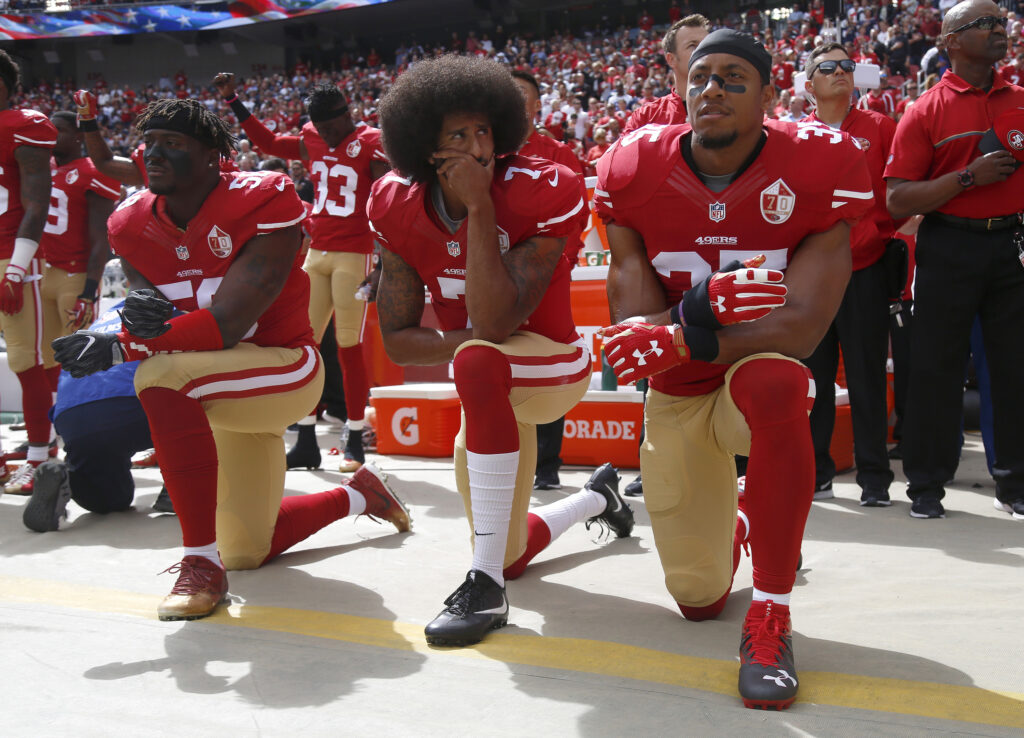
The national anthem is a special part of the pregame ceremonies at virtually all American professional sporting events.
It is an opportunity for spectators to honor America and reflect on the great liberties we are afforded as its citizens. When we stand for the national anthem, we honor these liberties that are secured and protected by the Veterans.
During an NFL preseason game, Colin Kaepernick of the San Francisco 49ers employed one such liberty, engaging in a peaceful demonstration during a pregame ceremony by sitting during the national anthem.
Speaking to NFL.com, he explained he would not honor a song nor “show pride in a flag for a country that oppresses black people and people of color.”
In doing so, he helped draw attention to the national discussion on police brutality, the treatment of African-Americans and the rights of Americans to protest the national anthem.
Soon, other athletes, across many sports, joined Kaepernick in their own showing of support of the protest against the racial injustice that plagues our nation.
Wary of his actions sending a disrespectful tone to service members and veterans, Kaepernick later clarified his intentions.
“I have great respect for the men and women that have fought for this country. I have family, I have friends that have gone and fought for this country. And they fight for freedom, they fight for the people, they fight for liberty and justice, for everyone,” Kaepernick told the media after protesting. “I’ve seen circumstances where men and women that have been in the military have come back and been treated unjustly by the country they have fought for, and have been murdered by the country they fought for, on our land. That’s not right.”
For some veterans, Kaepernick’s demonstration missed the mark.
“The national anthem isn’t about race or religion, it’s a symbol of freedom and sacrifice,” said Lisha Glien, a veteran of the United States Air Force. “It’s not right for him to turn it into a personal protest.”
Chris Dennison, also an Air Force veteran, shares the sentiment.
“I think across the board, most veterans would say it was in bad taste,” Dennison said. “It’s his right to protest. I’m proud to have defended his right to do so. However, he could have used his platform to do something more effective and less offensive to the military.”
Dennison also admits that kneeling in quiet reflection is a mild statement in comparison to burning flags in protest, which he calls “unacceptable in any situation.”
During America’s bicentennial in 1976, two protesters attempted to do just that.
In the fourth inning of a Los Angeles Dodgers versus Chicago Cubs baseball game, two would-be dissidents leaped the outfield fence and unfurled a United States flag, dousing it with lighter fluid.
Cubs center-fielder Rick Monday, who’d served in the Marine Corps Reserve for six years, didn’t hesitate. He charged the pair, grabbed the flag with his right hand, and ran from the protesters.
The crowd gave Monday a standing ovation. The scoreboard read: “Rick Monday—You Made a Great Play.”
It’s clear not everyone shares the same American experience.
Our experiences are shaped by our uniquely individual circumstances, including the neighborhoods we grow up in, the schools we attend, the gender we identify as, the sexual identity we live with, and certainly, the color of our skin.
As we celebrate this Veterans Day, it is not whether we as American’s are capable of looking outside our individual experience to acknowledge there is something wrong.
Veterans represent our best. These men and women are truly the epitome of patriotism.
These patriots have continually demonstrated the power of diverse individuals coming together in support of a common goal: The impossible becomes possible.
The key difference between veterans and anthem protestors is that veterans, instead of taking a knee, take a stand.
In doing so, they enable the rest of us to stand, sit or kneel on the sidelines and debate the validity, method or motivations of another.







